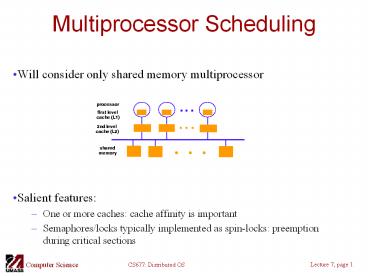Multiprocessor Scheduling PowerPoint PPT Presentation
Title: Multiprocessor Scheduling
1
Multiprocessor Scheduling
- Will consider only shared memory multiprocessor
- Salient features
- One or more caches cache affinity is important
- Semaphores/locks typically implemented as
spin-locks preemption during critical sections
2
Multiprocessor Scheduling
- Central queue queue can be a bottleneck
- Distributed queue load balancing between queue
3
Scheduling
- Common mechanisms combine central queue with per
processor queue (SGI IRIX) - Exploit cache affinity try to schedule on the
same processor that a process/thread executed
last - Context switch overhead
- Quantum sizes larger on multiprocessors than
uniprocessors
4
Parallel Applications on SMPs
- Effect of spin-locks what happens if preemption
occurs in the middle of a critical section? - Preempt entire application (co-scheduling)
- Raise priority so preemption does not occur
(smart scheduling) - Both of the above
- Provide applications with more control over its
scheduling - Users should not have to check if it is safe to
make certain system calls - If one thread blocks, others must be able to run
5
Code and Process Migration
- Motivation
- How does migration occur?
- Resource migration
- Agent-based system
- Details of process migration
6
Motivation
- Key reasons performance and flexibility
- Process migration (aka strong mobility)
- Improved system-wide performance better
utilization of system-wide resources - Examples Condor, DQS
- Code migration (aka weak mobility)
- Shipment of server code to client filling forms
(reduce communication, no need to pre-link stubs
with client) - Ship parts of client application to server
instead of data from server to client (e.g.,
databases) - Improve parallelism agent-based web searches
7
Motivation
- Flexibility
- Dynamic configuration of distributed system
- Clients dont need preinstalled software
download on demand
8
Migration models
- Process code seg resource seg execution seg
- Weak versus strong mobility
- Weak gt transferred program starts from initial
state - Sender-initiated versus receiver-initiated
- Sender-initiated (code is with sender)
- Client sending a query to database server
- Client should be pre-registered
- Receiver-initiated
- Java applets
- Receiver can be anonymous
9
Who executed migrated entity?
- Code migration
- Execute in a separate process
- Applets Execute in target process
- Process migration
- Remote cloning
- Migrate the process
10
Models for Code Migration
- Alternatives for code migration.
11
Do Resources Migrate?
- Depends on resource to process binding
- By identifier specific web site, ftp server
- By value Java libraries
- By type printers, local devices
- Depends on type of attachments
- Unattached to any node data files
- Fastened resources (can be moved only at high
cost) - Database, web sites
- Fixed resources
- Local devices, communication end points
12
Resource Migration Actions
Resource-to machine binding
Unattached Fastened Fixed
By identifier By value By type MV (or GR) CP ( or MV, GR) RB (or GR, CP) GR (or MV) GR (or CP) RB (or GR, CP) GR GR RB (or GR)
Process-to-resource binding
- Actions to be taken with respect to the
references to local resources when migrating code
to another machine. - GR establish global system-wide reference
- MV move the resources
- CP copy the resource
- RB rebind process to locally available resource
13
Migration in Heterogeneous Systems
- Systems can be heterogeneous (different
architecture, OS) - Support only weak mobility recompile code, no
run time information - Strong mobility recompile code segment,
transfer execution segment migration stack - Virtual machines - interpret source (scripts) or
intermediate code Java

